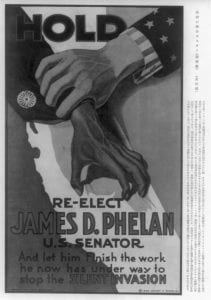
A reelection poster for James D. Phelan, a prominent California politician who strongly based his platform on anti-Japanese rhetoric. Wikimedia Commons, https://commons.wikimedia.org/wiki/File:Re-elect_James_D._Phelan,_U.S._Senator,_and_let_him_finish_the_work_he_now_has_under_way_to_stop_the_silent_invasion_LCCN96517829.jpg
Author: Nicholas Mays
Interviewer: Chloe Keefe
In the early 20th century, common knowledge held that “Caucasian” meant “white person.” However, the reverse was not necessarily true, until the Supreme Court, in 1922, handed down a statement that legally made it so. A Japanese man, attempting to apply for American citizenship, was turned down because he was not considered a white person, and so the Court said he was therefore not Caucasian. This was the first time that white was legally stated to mean Caucasian. The verdict was informed heavily by prejudices toward the Japanese. This prejudice towards a (now, legally) non-white group was instrumental in the creation of white racial identity.
